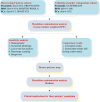Prostatitis, benign prostatic hyperplasia, and prostate cancer: a bidirectional Mendelian randomization study and clinical implications for these patients' populations
- PMID: 39695756
- PMCID: PMC11658280
- DOI: 10.1186/s13062-024-00575-x
Prostatitis, benign prostatic hyperplasia, and prostate cancer: a bidirectional Mendelian randomization study and clinical implications for these patients' populations
Abstract
Background: No authoritative books or guidelines are currently available for revealing the interrelationships of prostatitis, benign prostatic hyperplasia (BPH), and prostate cancer (PCa). Moreover, no consensus on this issue has been reached among previously published epidemiological studies or meta-analyses.
Purpose: We first took advantage of Mendelian randomization to clarify this issue and provide clinical implications for these patients' populations.
Methods: Bidirectional two-sample and mediator Mendelian randomization were applied to explore the causal relationships among prostatitis, BPH, and PCa. Sensitivity analyses, including phenotype scanning, heterogeneity, pleiotropy, leave-one-out analysis, and the Steiger test, were conducted to evaluate the robustness and reliability of our results.
Results: Our results revealed the interrelationships among prostatitis, BPH, and PCa via Mendelian randomization, confirming that genetic susceptibility to prostatitis or BPH could lead to increased risks of PCa directly or indirectly (P < 0.05). Moreover, mediator Mendelian randomization revealed four potential mediator pathways, including the prostatitis-BPH-PCa, the BPH-PCa-prostatitis, the PCa-prostatitis-BPH, and the PCa-BPH-prostatitis pathways. Based on these, we also provided clinical implications for prostatitis, BPH, and PCa patients' populations, respectively. Interestingly, a total of three vicious circles were revealed by us, including the prostatitis-BPH circle, the BPH-PCa circle, and the prostatitis-BPH-PCa circle. All of these three vicious circles contributed to the progression of benign prostate diseases to malignant diseases.
Conclusion: We successfully clarified the interrelationships among prostatitis, BPH, and PCa, providing clinical implications for these patients' populations. A total of three vicious circles were also revealed by us to provide novel ideas for future drug development and guide clinical decision-making.
Keywords: Benign Prostatic Hyperplasia; Clinical implications; Mendelian randomization; Prostate Cancer; Prostatitis.
© 2024. The Author(s).
Conflict of interest statement
Declarations. Ethics approval and consent to participate: None declared. Consent for publication: Not applicable. Competing interests: The authors declare no competing interests.
Figures





Similar articles
-
Causal relationship between prostatic diseases and prostate cancer: a mendelian randomization study.BMC Cancer. 2024 Jun 27;24(1):774. doi: 10.1186/s12885-024-12551-9. BMC Cancer. 2024. PMID: 38937672 Free PMC article.
-
Association between cathepsins and benign prostate diseases: a bidirectional two-sample Mendelian randomization study.Front Endocrinol (Lausanne). 2024 Jun 5;15:1348310. doi: 10.3389/fendo.2024.1348310. eCollection 2024. Front Endocrinol (Lausanne). 2024. PMID: 38904040 Free PMC article.
-
Bidirectional influence between benign prostatic hyperplasia, prostate cancer, and prostatitis and mental disorders: two-sample and multivariate mendelian randomization analyses.Aging Male. 2024 Dec;27(1):2419853. doi: 10.1080/13685538.2024.2419853. Epub 2024 Oct 25. Aging Male. 2024. PMID: 39460452
-
The controversial relationship between benign prostatic hyperplasia and prostate cancer: the role of inflammation.Eur Urol. 2011 Jul;60(1):106-17. doi: 10.1016/j.eururo.2011.03.055. Epub 2011 Apr 9. Eur Urol. 2011. PMID: 21497433 Review.
-
[Correlation of androgen receptor CAG repeats with the risks of benign prostatic hyperplasia and prostate cancer: a meta-analysis].Zhonghua Nan Ke Xue. 2014 Feb;20(2):172-6. Zhonghua Nan Ke Xue. 2014. PMID: 24520673 Chinese.
References
-
- Gasmi A, Bjørklund G, Noor S, Semenova Y, Dosa A, Pen JJ, Menzel A, Piscopo S, Wirth N, Costea DO. Nutritional and surgical aspects in prostate disorders. Crit Rev Food Sci Nutr. 2023;63(21):5138–54. - PubMed
-
- Sung H, Ferlay J, Siegel RL, Laversanne M, Soerjomataram I, Jemal A, Bray F. Global Cancer statistics 2020: GLOBOCAN estimates of incidence and Mortality Worldwide for 36 cancers in 185 countries. Cancer J Clin. 2021;71(3):209–49. - PubMed
-
- Ørsted DD, Bojesen SE. The link between benign prostatic hyperplasia and prostate cancer. Nat Reviews Urol. 2013;10(1):49–54. - PubMed
-
- Sandhu JS. Prostate cancer and chronic prostatitis. Curr Urol Rep. 2008;9(4):328–32. - PubMed
MeSH terms
Grants and funding
LinkOut - more resources
Full Text Sources
Medical

